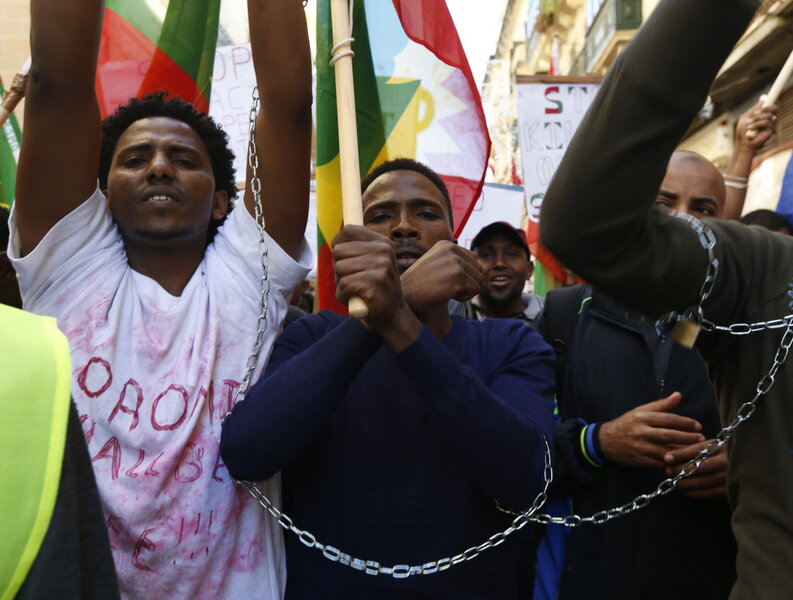In Ethiopia's pursuit of expansion, locals prove to be new roadblock
| SULULTA, ETHIOPIA
Walk past the China-Africa Overseas Leather Factory in the highland plains just north of Addis Ababa, and it's clear that it has had better days: Its gold plaque nameplate is dented, its windows smashed, and dozing soldiers from an elite military unit dot the compound.
“Oromia belongs to us,” hundreds of protesters chanted last month as they overran the $27-million Chinese-owned tannery on the edge of Sululta, according to the company’s guard.
For the last two months, a wave of demonstrations led by the Oromo people – Ethiopia’s most populous ethnic group – have been protesting a joint strategy between Addis Ababa, the country's capital, and the Oromia regional state. The proposal would allow the capital to expand into Oromo land, where up to 40 million people live. It's an official attempt to harmonize development of the capital with surrounding Oromo towns such as Sululta.
But opponents cast it as land grabbing, the latest effort by a federal government controlled by the minority Tigray ethnic group to take land from Oromo farmers and lease it to investors without adequate local consultation or compensation.
Indeed, for some here the so-called master plan is a continuation of a process that began over a century ago when Oromo settlements were colonized to establish Addis Ababa. But the tannery also represents the breakneck development of Addis Ababa, which has been boosted by a booming Ethiopian economy that the International Monetary Fund estimates will grow 8.7 percent this year.
“The land was taken from the farmers and they benefited nothing,” Aberash Gore, an Oromo farmer, says about the the leather factory.
Critics say that while Ethiopia’s efforts to industrialize by attracting foreign investment may be having some success, most Oromo feel their interests are not being sufficiently considered.
When Ethiopia began a big economic push around 2010, it was criticized for prioritizing national economic gains over the rights of locals. And though this particular protest movement has been successful – the government announced it would scrap the master plan last week – Oromo leader Merera Gudina says that widespread opposition to developments that are not built around the wishes and welfare of locals will continue.
“When both national and international investors come and farmers are pushed away for very small compensation, people see their livelihoods have been destroyed and are reacting to it,” he says.
Disgruntled locals
Sululta is a town is transition. Huts and small fields sit next to sprawling hotel compounds, half-built luxury homes, piles of rubble, and factories. The construction boom is underscored by businesses selling building materials, iron gates, and eucalyptus trunks for scaffolding.
The new tenants have brought new jobs and needed technology with them. The tannery itself is a product of Ethiopia’s strong ties with China and was backed by loans from the China-Africa Development Fund. The leather industry is a priority of the government because of the potential for converting a huge livestock population into high-value goods for export. But the local community is angered by the loss of grazing land, alleged release of toxic waste into nearby watercourses, and poor pay by the new companies.
“It’s a miserable life,” says Alemayehu Getachew, who gets paid $47 a month for stripping hair from hide at the tannery.
Among the properties attacked in Sululta was the foundation of late Prime Minister Meles Zenawi, a Tigrayan that engineered Ethiopia’s economic strategy as he strove to move Ethiopia beyond subsistence farming and boost productivity. (The attack suggests that the land grab grievances are tinged with political and ethnic nuances).
One of Mr. Meles’ export-focused schemes was to offer cheap land and water for flower farms so Ethiopia could compete with neighboring Kenya for the European market. The policy has had some success. It rapidly created an industry that earned more than $250 million in 2014 from greenhouses that are largely within a 100-mile radius of Addis Ababa, making them easy targets for protesters as seen with the Indian-owned Suprafloritech.
Angered by the master plan and reports that a nearby forest had been leased out, a group of about 50 young people burned down parts of the property last month. Complaints focused on low wages of $1.27 a day, and authorities offering compensation for displaced farmers at a rate lower than the rent paid by the company.
“The government took 90 percent of payment and gave 10 percent to the people,” says Solomon Gemeda, a local resident.
A Dutch agricultural company and Nigerian cement plant are among other international companies that have been attacked.
A new test
The Ethiopian government is aware of problems caused by insufficient consultation and corruption, but it's not considering rethinking generally successful development policies, says spokesman Getachew Reda. The government has borrowed heavily to expand roads, railways, and electricity networks, as well as attracting private investment for factories, hotels, and breweries.
Such ambitious projects are not just around the capital. In the south, near the Kenyan border, the state-owned Sugar Corporation is converting 700 square miles of land used by minority groups into plantations. The nation will benefit from foreign-exchange earnings, while communities such as the Mursi ethnic group will get jobs, public services, and agricultural assistance, according to government officials. Critics say it will lead to increased marginalization, impoverishment, and conflict.
In Oromia, a further test may come soon when the government picks a site to launch its latest mega-project: a plan to build an airport with the world’s largest passenger capacity. If handled properly, the scheme will not necessarily anger displaced Oromo, Mr. Getachew says.
“As long as people are part of the decision making, there is no reason why such a project can not go ahead, or should be considered a flashpoint," he says







